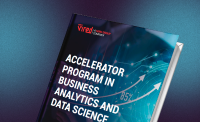In the dynamic realm of data science, a powerful process known as Exploratory Data Analysis (EDA) takes center stage, guiding us through the intricate landscape of information to uncover hidden gems of insights.
EDA in data science is not just a technique; it’s a compass that navigates us through the uncharted territories of raw data, transforming them into actionable knowledge.
With the aid of various statistical tools and visualization techniques, exploratory analysis illuminates patterns, detects anomalies, and sheds light on the underlying structure of the data.
In this article, we delve into the significance of EDA in data science, its role in extracting meaningful information, and how this process shapes the foundation of informed decision-making.

So, let’s embark on this journey of discovery and unveil the secrets that data holds through the lens of exploratory analysis.
What is Exploratory Data Analysis?
Exploratory Data Analysis (EDA), often referred to as the cornerstone of data science, is a skillful blend of art and science that involves meticulous scrutiny of data to unravel its intricate underlying structure, discern patterns that might otherwise remain concealed, and pinpoint anomalies that hold crucial insights.
EDA in data science serves as a guiding compass for data scientists embarking on their initial data exploration journey. This transformative process turns raw, seemingly chaotic data into a treasure trove of actionable insights.
Through a symphony of diverse statistical and visualization techniques, exploratory data analysis navigates the analyst through the labyrinth of information, helping to unearth outliers that defy convention, uncover elusive missing values, and decipher the nuanced distribution of variables within a given dataset.
Learn more about the Advanced Certification Program in Data Science & Analytics.

Get curriculum highlights, career paths, industry insights and accelerate your data science journey.
Download brochure
Why is Exploratory Data Analysis Important in Data Science?
EDA in data science is the bedrock upon which the entire analytical framework is built. The preliminary step bridges the gap between raw data and informed decision-making.
Data scientists can ensure that the insights extracted are accurate and relevant by thoroughly examining data before delving into complex models.
In business analytics, EDA in data science is a kin to a magnifying glass that uncovers trends, correlations, and potential opportunities hidden within the data.
This proactive approach enables organizations to make strategic choices and empowers them to anticipate market trends and stay ahead of the competition.
Exploratory Data Analysis (EDA) is a pivotal step in data science that calls for an arsenal of powerful tools to uncover the intricate insights hidden within the data. Let’s explore the key tools
that make EDA in data science a dynamic process of discovery:
- Python Libraries: Widely favored for its versatility, Python offers libraries like Pandas, Matplotlib, and Seaborn, which provide an expansive toolkit for conducting exploratory analysis. These libraries enable data manipulation, visualization, and statistical analysis.
- R Programming: Renowned for its statistical capabilities, R offers a rich set of packages like ggplot2 and dplyr, tailored for exploratory analysis. These tools facilitate data visualization, manipulation, and hypothesis testing.
- Excel: A classic choice for beginners, Excel offers a user-friendly interface for basic exploratory analysis tasks. It allows data sorting, filtering, and simple visualizations.
- Jupyter Notebooks: These interactive platforms seamlessly integrate code, visualizations, and narrative text, making EDA in data science a collaborative and explorative journey. Notebooks support various programming languages, including Python and R.
- Statistical Software: Specialized software like SPSS, SAS, and Stata provides advanced statistical analysis capabilities, making them suitable for in-depth EDA in data science, especially in research and academia.
- Business Intelligence Tools: Tools like Tableau and Power BI offer intuitive interfaces to create interactive visualizations, facilitating exploratory analysis for non-technical users.
- Command Line Tools: For the tech-savvy, command-line tools like awk and sed offer powerful text processing capabilities, aiding in initial data exploration and cleaning.
- Machine Learning Platforms: Platforms like RapidMiner and KNIME combine EDA with machine learning, enabling data scientists to extract insights while preparing data for predictive models.
- Web-based Tools: Online platforms like Google Colab and DataCamp offer cloud-based environments with pre-installed libraries, allowing users to perform EDA in data science without local setup.
- Version Control Systems: Tools like Git enable efficient collaboration and tracking changes during exploratory analysis, ensuring transparency and reproducibility.
In the multifaceted landscape of exploratory analysis, these tools serve as the compass, guiding data scientists and analysts in deciphering the language of data and unveiling its hidden stories.
Through the lens of exploratory data analysis, these tools empower us to transform raw data into actionable insights, shaping the future of decision-making.
Market Analysis With Exploratory Data Analysis
In the realm of market analysis, EDA in data science is a guiding beacon. It enables businesses to decipher the intricate landscape of consumer behavior, market trends, and competitive forces.
By conducting thorough exploratory analysis, businesses can uncover customer preferences patterns, identify potential market gaps, and fine-tune their strategies for optimal results.
Click here for Understanding Unsupervised Learning: Behind the Algorithms.
Exploratory Data Analysis (EDA) Using Python Libraries
Python, a programming language celebrated for its simplicity and versatility, is a preferred choice for conducting EDA in data science. Python libraries like Pandas, Matplotlib, and Seaborn offer a rich ecosystem of functions tailored to data manipulation, visualization, and statistical analysis.
Data Cleaning
Data cleaning is a mandatory pit stop before delving into the depths of analysis. This process involves identifying and rectifying dataset inconsistencies, errors, and inaccuracies.
A clean dataset lays the foundation for accurate insights, ensuring that decisions are based on reliable information.
Missing Values
Missing values are the chinks in the armor of data analysis. EDA in data science helps uncover the extent of missing data, assess its potential impact, and decide on strategies for handling it.
This might involve imputing missing values based on statistical methods or making informed decisions about whether to exclude certain data points.
Univariate Analysis
Univariate analysis is the process of analyzing a single variable in isolation. This technique involves using descriptive statistics and visualization tools to understand the variable’s distribution, central tendency, and variability.
It’s like spotlighting a single actor in a play, observing their every move and gesture.
How Univariate Analysis Supports Decision Making
Univariate analysis provides valuable insights that can guide decision-making. For instance, in retail, understanding the distribution of purchase amounts can help determine pricing strategies. Similarly, analyzing patient age distribution can influence resource allocation in healthcare.

Methods for Conducting Univariate Analysis
Univariate analysis encompasses various methods, including measures of central tendency (mean, median, mode), measures of variability (range, variance, standard deviation), and data visualization techniques like histograms, box plots, and density plots.
Advantages and Limitations of Univariate Analysis
Advantages of Univariate Analysis
- Simplicity: Easy to understand and interpret, making it accessible to a wide audience.
- Initial Insights: Provides a quick overview of a single variable’s characteristics.
- Basic Trends: Reveals basic patterns and trends in data distribution.
- Data Cleaning: Helps in identifying outliers and errors for further data refinement.
- Decision Support: Offers foundational insights for informed decision-making.
Limitations of Univariate Analysis:
- Lack of Context: Ignores interactions between variables, missing a holistic view.
- Incomplete Picture: Fails to capture complexities that involve multiple variables.
- Limited Inference: Cannot uncover cause-and-effect relationships or correlations.
- Data Oversimplification: Might oversimplify data, leading to erroneous conclusions.
- Reduced Predictive Power: Doesn’t provide predictive insights without considering multiple factors.
Conclusion
Exploratory Data Analysis stands tall as the guiding torchbearer in the intricate realm of data science.
Its multifaceted techniques unravel hidden insights, set the stage for informed decision-making, and lay the groundwork for advanced analytical methodologies like machine learning.
As businesses continue to rely on data to drive strategies, the significance of EDA in data science remains unwavering—a compass that points toward success in a data-driven world.
FAQs
Involves measures like mean, median, mode, and visualizations like histograms. Part of exploratory data analysis, it unveils insights from a single variable's perspective.
Python libraries (Pandas, Matplotlib), R programming, Jupyter Notebooks, and business intelligence tools. These aid in performing exploratory data analysis efficiently.
Exploratory data analysis bridges data and decisions. It uncovers patterns, outliers, and trends, laying the foundation for informed choices in data science and beyond.
EDA in data science is the art of probing data to reveal hidden insights. It's the compass guiding analysts through the intricacies of raw data, facilitating exploratory analysis to make sense of it.
While useful, univariate analysis focuses solely on one variable. It may miss interactions between variables, underlining the need for a holistic exploratory analysis approach.










